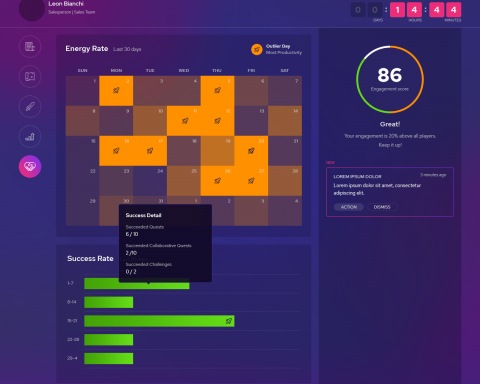How you can increase your results with it?
Games are often more stimulating than “real life”, aren’t they? It is common to lose track of time when we are involved in some game, it may be a video game, cards or a basketball. However, time seems like an eternity when we are doing a routine activity (remember those reports that close your work but are boring to be done).

Now let’s take an analytical view and understand the pattern that makes games so seductive. I have listed here 4 features:
Games have a clear objective, the player knows where he needs to go, what he needs to deliver. For example, in soccer the objective is to make as many goals as possible and to win you need to make more goals than the opposite team.
The player receives feedback in real time for the actions he performs in the game. Like in a video game where we score points right after a particular mission or we lose a life if we fail.
Rules are defined , there is a clear delimitation of what is allowed and what is forbidden, and cheating does not offer the player the same sense of victory.
Not every game is fascinating to everyone, right? The game that holds us is the one that has a balance between challenge and competence, that is, the level of difficulty of the game is in line with our ability to execute it , otherwise we would be bored or frustrated and we would abandon it.
If on the one hand games hold our attention, the same does not happen in our daily life, this is because we do not always find these characteristics, the rarer it is still to find activities that group the 4. Thus, making an analogous scenario creation exercise arises an issue.
What if we used game thinking to apply it to the real world?
It is then that the Gamification arises, which has been used by many organizations with the main purpose of provoking engagement with its beneficiaries, customers, employees and / or suppliers.
But you must be wondering, after all what is gamification?
Briefly gamification is the act of bringing the gaming experience to the real world without turning that real world into something imaginary. That is, you need to use game design and elements to enhance the user experience and thereby increase engagement in the product / service or process without taking them out of the real world. This practice stimulates and encourages your players to perform day-to-day activities with rewards for real and / or virtual prizes.
To gamify something it is necessary to use 3 factors:
Game elements: like medals, levels, energy bar, progress bar, missions, ranking, points.
Game design techniques: gamification is not only the union of game elements, even less still less randomly, we need to think like a game designer, create the story, the rules, decide which element to use to trigger certain actions.
Contexts that are not games: to gamify, you will use game elements, you will think like a game designer but you will not create a game. Confusing ? No! This is because even gamification offering fun, this is not the ultimate goal. The people involved are doing real and everyday actions to achieve a real goal. There is experience of a game but the purpose of this experience is something out of the game.
A practical example would be of a gym that wants to increase the engagement of its clients. It can create an experience where people score points for frequency and a medal for completing their weekly or monthly training. These customers could see the others and thus compete and give incentives. There would be a ranking of comparison between groups of people and a change of level by completing a training program. This action gives the experience of exercising at a gym a feeling of getting involved in some kind of game.
In this example, the person actually does physical activities and their actual actions feed the gamification, unlike a game where the person has an avatar (virtual character) and needs to participate in a virtual race with clicks.
Before starting your gamification, watch out!
Gamification is not turning everything into a game, or just entering scores, ranking and / or trophies into your system at random. Gamification requires strategic thinking and understanding of the profile of users, to turn current activities into more rewarding experiences.







